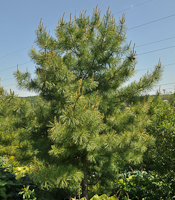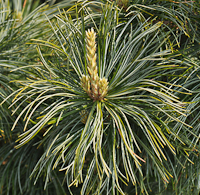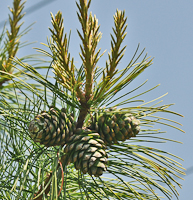 Sudden
death of pines or other evergreens may often be caused
by the pinewood nematode. It is usually transmitted by
long-horn beetles and has been found in more than 25
species of evergreens. Scotch (Pinus
sylvestris), Austrian (Pinus
nigra), and Japanese
species are very susceptible to this disease. Since the
pinewood nematode is native to the U. S., most native
pines are resistant to it. The sawyer beetle appears to
be the primary carrier (vector) for this disease,
although other wood-boring beetles may also transmit the
nematode.
Sudden
death of pines or other evergreens may often be caused
by the pinewood nematode. It is usually transmitted by
long-horn beetles and has been found in more than 25
species of evergreens. Scotch (Pinus
sylvestris), Austrian (Pinus
nigra), and Japanese
species are very susceptible to this disease. Since the
pinewood nematode is native to the U. S., most native
pines are resistant to it. The sawyer beetle appears to
be the primary carrier (vector) for this disease,
although other wood-boring beetles may also transmit the
nematode.
The symptoms are minimal but dramatic. If a tree is infected in the
fall, brown limb die-outs (flagging) in or near the crown, or an absence
of candle growth will usually occur. The most noticeable symptom appears
in mid to late summer when the greatest need for moisture is required,
and blocked by the nematodes in the resin canals. In a matter of six to
eight weeks the tree becomes a dull green, to yellow, and finally brown.
Depending on the age and condition of the tree, it may take up to one year
before it is fully destroyed by wilt. In some cases, death occurs from
a combination of pests.
 The disease cycle is simple and direct. In early to mid-summer the sawyer
beetles emerge from dead pine trees with pinewood nematodes in their air
passages. As they feed on several trees, nematodes leave the beetles and
enter through the feeding wound. From this point the nematodes invade the
resin canals, cambial tissue, and cortex. With a short life cycle, and
a complete generation of nematodes every four days in optimal conditions,
the population multiplies exponentially. As a result, the water transport
system is blocked and the tree dies.
The disease cycle is simple and direct. In early to mid-summer the sawyer
beetles emerge from dead pine trees with pinewood nematodes in their air
passages. As they feed on several trees, nematodes leave the beetles and
enter through the feeding wound. From this point the nematodes invade the
resin canals, cambial tissue, and cortex. With a short life cycle, and
a complete generation of nematodes every four days in optimal conditions,
the population multiplies exponentially. As a result, the water transport
system is blocked and the tree dies.
Management of the nematode population is to reduce the spread of the
disease. Dead trees must be cut down and burned before the sawyer beetles
emerge in early to mid summer. Pruning out flagged branches in the crown
may only postpone tree mortality. If you want positive ID, these branches
can be sent to the department of entomology.
 Wood from infected trees must be handle properly to prevent spreading
the disease. The key here is to stop the reproduction of nematodes and
beetles by heating the wood. This can be done by immediate burning, fumigation
of chopped wood for later burning, or placing chopped wood under black
plastic (completely surrounding wood) for several months allowing the sun
to heat and destroy the pests.
Wood from infected trees must be handle properly to prevent spreading
the disease. The key here is to stop the reproduction of nematodes and
beetles by heating the wood. This can be done by immediate burning, fumigation
of chopped wood for later burning, or placing chopped wood under black
plastic (completely surrounding wood) for several months allowing the sun
to heat and destroy the pests.
When replanting pines, use native disease resistant species. Avoid planting
susceptible pines such as Austrian, Japanese, or Scotch, keep properly
watered and fertilized, and control other pests that will stress trees.
At this time, there is no cure for pinewood nematode
infestation. It is found in over 35 states, being native to the Americas,
and is devastating to ornamental and Christmas tree plantings.



